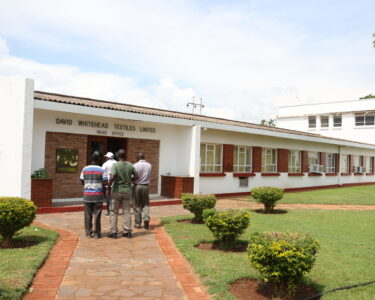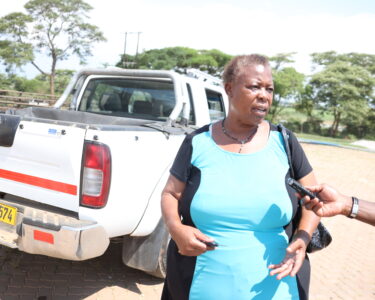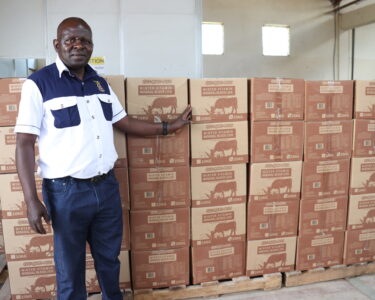… New biological oxidation plant is a game changer
For 48 years (between 1967 and 2015), the Cam & Motor Mine in Kadoma was a dead mine. Today it boasts of the latest technology in the processing of “stubborn” gold – a biological oxidation plant, the only one in Zimbabwe and the second-largest in Africa. As such the mine’s efficiency level has gone up, which is good news for Zimbabwe’s economy. Baffour Ankomah reports.
Would you ever associate gold with stubbornness? When you wear that nice gold chain around your neck (particularly women) and put that adorable gold watch on your wrist, do you ever think that gold could be stubborn? Well, come with me to Kadoma, to a place called Cam & Motor. Believe me, it is a gold mine, not a car dealership, even though they have ore bodies and pits named after different parts of a car. There is the Cam, there is the Motor, there is the Petrol, and there is the Diesel. And all this is about gold and its production.
The names were coined by the early white settlers who came with Leander Starr Jameson and the Pioneer Column, and, God bless their hearts, they “discovered” the ore deposits now being mined by Cam & Motor, one of the four mines owned by RioZim, which itself started life as Rio Tinto Southern Rhodesia Ltd at its incorporation on 29 August 1956 to exploit the nickel deposits at Zhombe (70 km southwest of Kadoma) in the Kwekwe District of the Midlands Province.
That establishment became known as the Empress Nickel Mine, the first operation that Rio Tinto, the Anglo-Australian multinational, established outside Europe. Rio Tinto itself has an interesting history. Founded in 1873, it is now the world’s second largest metals and mining corporation. But back in 1873, it was named Rio Tinto because the group of investors who founded the company purchased their first mine on the River Tinto at Huelva in Spain from the Spanish government. Rio is “river” in Spanish and Portuguese.
So the company was named after the River Tinto, which is in southwestern Spain. Its source is in the Sierra Morena mountains of Andalusia. Flowing generally south-southwest, it reaches the Gulf of Cádiz at Huelva. The gulf, a part of the Atlantic Ocean, washes off the southern shores of Portugal and Spain and the northern coast of Morocco at the western end of the Strait of Gibraltar.
“The Rio Tinto river,” according to Wikipedia, “has a unique red and orange colour derived from its chemical makeup that is extremely acidic and with very high levels of iron and heavy metals.” So the metals and mining investors of Rio Tinto chose an apt name for their company back in 1873.
Today Rio Tinto Southern Rhodesia Ltd, which is now RioZim, operates four mines in Zimbabwe – the Renco Mine at Nyajena (112 km southeast of Masvingo), the Dalny Mine at Chakari (45 km north of Kadoma), the Empress Nickel Mine in Zhombe, and the Cam & Motor mine, right inside one of the southern suburbs of Kadoma.
In its heyday in the late 1960s, the Empress Nickel Mine controlled the Empress Mine Township which had two separate residential areas, the best one with bigger and more beautiful houses was for whites only, and the other not-too-good one was for blacks only. Racism (or in this case, looking down on blacks and treating them as sub-human) is a disease indeed.
But that is a subject for another time. Today the focus is on Cam & Motor Mine, which was opened in 1912, exactly 22 years after the Pioneer Column had rolled into town in 1890. During its glory years, Cam & Motor held the national record as the deepest underground mine in Rhodesia, going as much as 2,000 metres underground. But the glory years slowly ebbed away, to a point where as low as 8 grammes per tonne was the value of the ore being mined.
By 1967, the mine’s operations had become so economically unsustainable that it had to close down. Thus from 1967 to 2015, there was no mining at all at the present site in Kadoma, until RioZim embarked on a 3-year exploration programme between 2009 and 2011 to investigate the resource, and came up with a different model of exploiting the gold. This culminated in the re-opening of the mine and its fashionably-named pits. The whole process cost RioZim US$70m to complete.
Change of mindset
Irvin Nyamukondiwa, Cam & Motor’s general manager, told a visiting team of Brick by Brick editors in late November 2022 that there was a change of mindset in 2015 “whereby after our exploration, we realised that this ore body can be mined through open pit that then goes underground. The motivation was that the ore body was wide, and open pits are less costly and much safer than going underground”.
Before the change of mind, Cam & Motor was processing its ores at its sister Dalny Mine, 45 km from Kadoma. But in 2016, RioZim built a processing plant at Cam & Motor, so the ore that was being processed at Dalny could now be processed at Kadoma.
The trouble, however, was that in an average pit, especially the pits in Kadoma, the ore from the first 13 metres is oxide material, which is processed through ordinary carbon and leach (CaL) procedure. But as the pit goes deeper, the ore becomes much firmer and fresher, which, at around 50 or 60 metres, becomes sulphuric and cannot be treated through the CaL process because the ore has now become oxidised. This is where gold becomes stubborn and difficult to “liberate”.
For Cam & Motor, stubborn gold became even more stubborn around 2018-2019 as its pits reached 30 to 40 metre depths. General Manager Nyamukondiwa tells how they were still “liberating” the gold but with much more difficulty, resulting in poor production figures.
The weekly production figures went as low as 6 kg and 10 kg of gold. “We were not recovering the gold, we were throwing the gold away,” recalls Nyamukondiwa. “So we went through a hiatus where we temporarily stopped processing at Kadoma and moved it to one of our sister mines called One Step, which is near Battlefield, where the material was oxide.
“But the challenge with the One Step operation was that in as much as it was oxide, the grades were rather low, and the hauling distance of about 65 km made it not so good economically to continue with that operation.”
RioZim then decided to move Cam & Motor’s operation to a different level by building a biological oxidation plant (or Biox Plant for short) at Kadoma to “liberate” the stubborn gold that had now become too stubborn for anybody’s comfort.
The Biox Plant cost US$45m to build, on top of the US$70m that RioZim had already spent on re-opening Cam & Motor. The Biox Plant uses bacteria to oxidise the gold ores and makes it possible for the now-tamed stubborn ores to be treated in the CaL Plant.
Nyamukondiwa explained the complicated process involved in taming the stubborn ores: “We crush our ores as normal, we float it to get the concentrate of the gold-bearing mineralisation, and we feed the bacteria with this concentrate. The bacteria eat up the sulphides and release the gold to be available for the leaching process. And we push the material from our Biox Plant to our CaL Plant and process it.”
Game changer
The Biox Plant, the first in Zimbabwe and the second largest in Africa, came on stream in February 2022 and was officially commissioned by President Emmerson Mnangagwa in April 2022. The impact has been phenomenal. Instead of the depressing 6-10 kg of gold per week that Cam & Motor was producing before April 2022, the company is currently doing 19-20 kg per week, and will soon hit 35 kg per week, thanks to the new efficiency levels brought by the Biox Plant.
“It is a success, believe me,” Nyamukondiwa told Brick by Brick. “There is no other technology in Zimbabwe that is environmentally friendly to treat such material. It is a game changer.”
The general manager went on: “I will take you back to how sulphides were treated in Zimbabwe in the past. If you look at Athens Mine in Mfuma, and even ourselves at Cam & Motor when our mine went down to 2,000 metres, you saw big chimneys or roasting plants because of the sulphuric nature of the ores. These produced sulphur dioxide, which, if it went into the atmosphere, caused acid rain.
“The dump sites also brought about acid mine drainage, which caused very serious complications not only to the communities in which we mined, but also to nearby farms and the underground water. So what the Biox technology does, because we are using bacteria, it eats up the sulphides and there is little or no environmental contamination.”
Even better, the bacteria do not affect humans. “Humans don’t even see the bacteria, they are contained in what we call reactors, very big tanks,” Nyamukondiwa told Brick by Brick. “They have their own ecosystem. They are produced in the big tanks, they eat there, they die there. It is continuous. It is an organism that is born there, that lives its life there, that dies there and continues the cycle.
“They are very, very particular about what they eat and the temperatures in which they reside. They are also very particular about the conditions in which they live. If you upset them, they go to sleep. If you give them toxins like oil and grease, they die. One of our major issues currently is electricity supply interruptions by ZESA. So if power goes out for a prolonged period, they reduce their activities and go dormant. So they have to be kept in good and proper conditions,” Nyamukondiwa added.
Generally, each bacterium breaks into two every 12 hours. So they reproduce themselves in their billions, and the company keeps the culture alive and going. But to wake the bacteria up from a dormant state to an active state takes a good 15 days. Rajgopal Swami, the RioZim Group chief financial officer, told Brick by Brick that unplanned electricity interruptions by ZESA had cost Cam & Motor 40% of production time between January 2022 and November 2022.
Said Swami: “The major challenge we are facing right now is ZESA. You know if you have planned outages, we can manage. But if we have unplanned outages when the power goes off, to switch from the power to the generator takes some time, and within that time the bacteria start going off to sleep, and if we are not quick enough and not careful enough, everything becomes dormant, and then it could take as long as 15 days for the bacteria to wake up.
“So that is one of the issues we are facing. If you don’t have ZESA, you don’t have production. And if you don’t have production, you don’t have gold. And if you don’t have gold, the vicious cycle begins, and you don’t have production that helps the national economy to grow.”
To solve the electricity problem, RioZim has proposed to build solar plants to produce 75 MW of power across its four mines, but funding problems have delayed the solar projects.
The importance of the Biox Plant
Contextualising the importance of the Biox technology to gold production in Zimbabwe, Swami explained that much of the gold available in the country “is actually in sulphuric form” and very stubborn to “liberate”.
“Oxides [which are easier to process] are just available for the first 20 or 30 metres, maybe 40 meters,” Swami said. “Beyond that the entire gold all over Zimbabwe is sulphuric. So having a plant like our Biox Plant can open up the country’s wealth and help it to get a greater production of gold and more forex which will bring better economic growth and more wealth creation.
“So this Biox Plant is a pioneering effort that we have done here, and we think it is already a success. Though you always have teething problems and challenges in terms of how the conditions have to be optimally met and so on, but when this Biox Plant becomes a bit more popular, you will find a lot of mines going for this technology.
“What we can offer right now is to give other mines the opportunity to bring in their concentrates for processing on a tolling basis or any other commercial basis. These are the two benefits that I can think of in putting up this plant,” Swami added.
No wonder, the Biox Plant now looms so large in the constellation of Cam & Motor to the point where the company’s general manager in charge of engineering and projects, Munetsi Machikicho, waxes so lyrical about it. And he loves his technical jargon.
“The background to biological oxidation,” he told Brick by Brick, “is actually the geology of the gold resource that we sit on. It is refractory or stubborn, meaning you cannot extract it conventionally as we do where gold is amendable. This is refractory because of compounds of iron and sulphur that occlude the gold.
“So the gold is in a matrix that even after grinding it to expose the gold particles, cyanide which is the chemical used to extract gold, cannot go and attack the gold particles. We therefore dissolve the ore and bring it out into a solution where we can capture the gold as normal. So Biox is an intervention to bring down that stubbornness and take away the refractoriness of the gold, using biological oxidation means, which is just a bacteria culture that is grown and adapted for this specific resource.”
Machikicho continued: “So for a resource such as ours, without this intervention, we wouldn’t have a mine. It wouldn’t be economic. We wouldn’t be able to harvest that mineralisation. That is why we have this Biox Plant here. There is, at the moment, only 6 or 7 of such plants working in the whole world, even though a total of 13 has been built across the world. This technology is about 40 years old, it was developed in South Africa and has spread as far afield as China, Australia, and Kazakhstan. In Africa, it’s only South Africa, Ghana and Zimbabwe that have got biox plants.”
The largest biox plant in Africa is located in Obuasi, Ghana, which, for nearly a century, held the record as the single-richest gold mine in the world. Nick Holder, a South African and Cam & Motor’s Biox Plant manager, who has worked in Ghana, Philippines, South America, China, Kazakhstan and other countries, believes that the way forward for mining companies that have “stubborn” gold deposits is to choose the biox technology.
“Biox is not that difficult, yet environmentally friendly,” Holder said. “In contrast, pressure oxidation is much more expensive, and in these days pressure oxidation is out of the equation because of environmental issues. I hope Zimbabwe will have a few more biox plants because there is quite a lot of refractory gold ores in the country.”
Bright future beckons
Another senior Cam & Motor official who can’t stop singing the praises of the Biox Plant is Zondai Setete, the company’s plant manager. According to him, the Biox Plant has made life easier for everybody at Cam & Motor.
“With the coming in of this technology, it has allowed us to claw back the years to go to our usual good recoveries, allowing us to have 72% recoveries or thereabouts,” Setete said. “And we are continuously going up because we are now dealing with a mixture of oxides and sulphides, though basically they are stubborn in nature.
“But come one or two months from now, we will be treating predominantly sulphuric material which, thanks to the Biox Plant, will be easy to process. So we are looking at getting efficiencies of 5% or more on top of the 72% we are currently doing. Eventually we will improve our efficiencies across the whole spectrum.”
Setete, therefore, sees a bright future ahead of Cam & Motor. “The future is very bright, very bright indeed,” he said. “We are looking at breaking the 100 kg of gold per month barrier. I am sure within the next four to eight weeks, we should be pouring 25 kg of gold per week to take us to 100 kg per month, and even further beyond.”
That will be very good news for Zimbabwe’s mining sector and the national economy generally. If that happens, the company will be able to employ more people, which means better production figures and more royalties and taxes for the country.
Cam & Motor currently employs a workforce of 850, made up of 750 permanent workers and 100 temporary ones. Twenty per cent of the workforce is female, one of which is Olivia Dhlamini, the senior biox metallurgist. She has been working for RioZim for 12 years and has been involved in different projects across the Group, an effort which has finally landed her at “the exciting biox technology” at Cam & Motor (see her expanded profile on page….)
Support by Second Republic
To help matters, the Second Republic has provided unstinting support to Cam & Motor and the RioZim Group in general. According to General Manager Nyamukondiwa: “The Second Republic has been very, very supportive. We’ve got very good assistance from the Ministry of Mines.
“They appreciate that we are mining in a built-up area so we have to be very, very prudent in how we coordinate our activities. The ministry has also been very helpful in relaxing some of the bureaucracies that we encounter. It’s an open-door policy now. They can be very tough as our regulatory body, but the atmosphere, the working relationship, is quite cordial, it’s quite good,” Nyamukondiwa added.
Nevertheless, the company has been suffering from “a perennial” forex problem which has hampered its solar projects and other operations. By law, 40% of the company’s forex is liquidated by the interbank system, but “the interbank doesn’t follow market sentiments and therefore we do have a problem,” explained Swami, RioZim’s chief financial officer.
He said RioZim has brought up the issue with the authorities on several occasions, but a solution has not yet been found. “In fact, when the President came here to commission the Biox Plant [in April 2022], we brought up the forex issue with him as well, and he actually said ‘I will sleep on it.’”
Elsewhere, partially because of the 22-year-old Western economic sanctions on Zimbabwe, and partially because of “negative perceptions” of Zimbabwe abroad, RioZim has found it difficult to raise funds for its solar and other projects. “Some countries don’t, or wouldn’t, like to lend to us because of the sanctions,” Swami disclosed.
“The other reason is that lenders outside the country are worried about how to repatriate their earnings. And although we are trying to tell them that once you’ve got governmental approval and the Reserve Bank and the relevant ministries have signed up, repatriation of earnings is not something you need to worry about. But somehow breaking down the perception and changing it is a long-drawn process which we are fighting. I am sure we will get there.”
Regarding the government’s new policy on payment of royalties (50% in cash and 50% in refined mineral) by mining companies dealing in gold, diamonds, lithium and the platinum group of minerals, Swami said RioZim was “neither happy nor unhappy” with it. “We are waiting for clarity. Right now, we don’t know exactly how it is going to be done.
“But if you look at the way we deal with our gold, whatever gold we produce, we hand it over to the government, and then the government may decide to keep part of it in their safe and not liquidate it, but we do hand over all the gold we produce to the government and we get our payment in return. How the new policy will mean in terms of how much the ratios will change or how much we get and what we don’t, is right now not clear for us to be able to comment on it.
“But as I have said we hand all our gold to the government, so we don’t think the new policy will make a very big change. It is not as if we are keeping some of the gold and that gold will now go to the government. No, it is not like that. If we produce 20 kg, all 20 kg goes to the government [via Fidelity Printers and Refinery]. Fidelity then deducts a 5% royalty and pays us the balance That 5% royalty is what the government now wishes to keep part of as refined gold and part as cash.”





